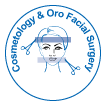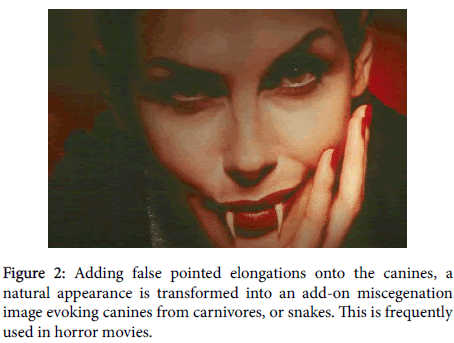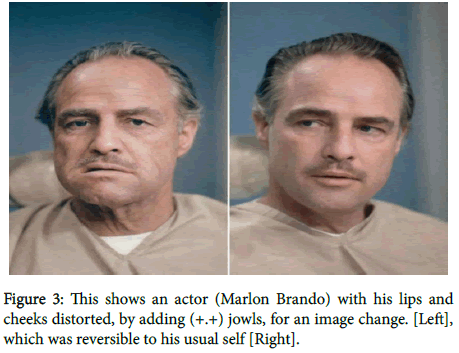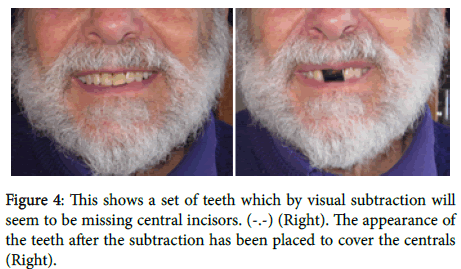Review Article Open Access
Theatrical Dentistry: Principles and Practice
Touyz ZGL*
McGill University, Faculty of Dentistry, Montreal PQ, Canada
- *Corresponding Author:
- Touyz ZGL
Director and Professor
Periodontics McGill University
Faculty of Dentistry Montreal PQ, Canada
Tel: 514-398-7203
Fax: 514 938 8242
E-mail: touyzlouis@gmail.com
Received date: December 05, 2015 Accepted date: February 03, 2016 Published date: February 06, 2016
Citation: Touyz ZGL (2016) Theatrical Dentistry: Principles and Practice. Cosmetol & Oro Facial Surg 2:106. doi:10.4172/jcofs.1000106
Copyright: © 2016 Touyz ZGL. This is an open-access article distributed under the terms of the Creative Commons Attribution License, which permits unrestricted use, distribution, and reproduction in any medium, provided the original author and source are credited.
Visit for more related articles at Cosmetology & Oro Facial Surgery
Abstract
Introduction: Esthetic dentistry (ED) emulates idealized natural form, demands no accommodation, is free of gratuitous decoration, is always in perfect use, is durable, permanent and in harmony with fault-free function. Cosmetic dentistry (CD) embraces some of these principles, but does not necessarily satisfy all. The acme of ED is pristine blemish free dentistry. The zenith of CD is theatrical dentistry (TD), which does not satisfy the therapeutic principles of esthetic dentistry in the short or long term. TD is essentially an appearance modification for visual effect, tolerates temporary dysfunction and may be realized through total mouth modification (ΣMM), with some influence on various functions.
Aim: This paper defines principles of TD and presents verbally visualizing concepts demonstrated by this partial formula:
ΣMM=ƒ{(A+.+) v (B-.-) v (CX.X) v (D÷.÷)}
TD is realized by ephemeral modifications through adding (A+.+), subtracting (B-.-), repeating (CX.X), or miscegenating (D÷.÷) component oral features. The ‘v’ represents the “inclusive or”. The full formula is presented and constructed in the text. Primary and secondary components are involved in TD.
Discussion: Using these, guiding principles for practicing TD by dentists and make-up artists are formulated. These principles are: Do no harm; Ensure continued health; Induce no pain; Minimize discomfort to subjective tolerable levels; and Appearance modification for visual effect is paramount. The main missionary intention of TD is not therapeutic, but rather image changing.
Conclusion: All TD procedures are short term, temporary, and fundamentally reversible. Long term form and function of the individual are not compromised.
Keywords
Cosmetic; Dentistry; Esthetic; Mouth; Restorative; Risorial; Smiles; Temporary; Theatrical
Introduction and Background
Primary differences between Esthetic and Cosmetic Dentistry have been defined Esthetic dentistry (ED) is therapeutic, emulates idealized nature, demands no tissue or physiological accommodation, is free of gratuitous decoration, is durable, permanent and in harmony with good form and function. The acme of ED is a pristine blemish free natural dentition that fulfils all natural activities, and performs, looks and survives optimally [1-4]. Cosmetic dentistry (CD) does not necessarily emulate nature, can be therapeutic, should be functional, may evoke a vital tissue response, may have extra decoration, may not be in perfect harmony with adjacent forms, is not permanent or durable, and other than appearance may function reasonably well. The information, news and entertainment industry moved from frugal primitive visual effects for amusement in the nineteenth century, through the twentieth century, with spectacular developments of mass communications, leisure and entertainment media. Entertainment has embraced growth from live theatre, photographic stills, silent movies, sound movies, cartoons, 3-D blockbusters, Imax experiences, drive-in movies, home movies, computer generated images, to compact disc renditions of entertainment, and more. Not only does the media inform, educate and entertain, it also provides untold numbers of workers with a variety of specialized jobs. The range of requirements for modified facial images is limited only by boundaries of imagination and creativity. Consequently visualizers or creative make-up artists frequently change real peoples’ mouths to conform to an imaginary concept for a visual effect in the entertainment industry.
The zenith of CD is theatrical dentistry (TD), which may, but usually does not, emulate ideal nature. While ED and CD include appearance modification, and both can be therapeutic for recipients, the specialized field of mouth and smile modification (MM) for a visual and emotional reaction on the observer only, constitutes a subdivision of CD and is appropriately termed theatrical dentistry (TD). Many articles address principles, aspects and problems relating to smiles and risorial analysis in orthodox dentistry [5-17], but publications as guidelines for TD are exiguous. Neither are there any fundamental principles or formalized concepts of TD to assist dentists in the published dental literature. When called upon by the entertainment industry, visualizers or make-up artists, those who wish to develop TD skills, (to procure desired visual impacts safely and effectively), require a set of pragmatic principles, which could facilitate planning and guide TD practice. Hopefully these will be of enormous help for interested dentists.
Aims
The purpose of this paper is to present primary paradigms of TD. The aims are:
1. To fractionate the mouth and smile broadly into primary and secondary components.
2. To develop a symbolic formula for mouth and smile modification as the total effects (Σ) of adding (+.+), subtracting (-.-), repeating (X.X) or miscegenating (÷.÷).
3. To present examples demonstrating how summed features of each component, show conceptual design modifications of the mouth and its contribution to facial appearances.
4. To enunciate principles which dictate practice policies for theatrical dentists and/or creative make-up artists; these should ensure safe practices, prevent chronic residual tissue damage, allow optimal long term oral health, and ensure sustained good form and function of recipients, after the mandatory reversal of the TD.
5. To provide a working hypothesis and sound guidelines for dentists studying or practicing TD.
Theatrical Dentistry
Modifiable oral constituents
It is important to dissect out conceptual constituents of the mouth in order to describe and ultimately manage each part individually, but yet with each part also being a portion of the whole. Consequently the mouth is divided into primary and secondary components: primary components focuses oral appearances, while secondary components embrace the whole face, but here specifically lower third. These constituents are used for conceptual oral and facial analysis respectively in TD changes (See below).
Primary oral components: The primary components directly affecting the smile appearance are the lips (Lp), gums (G), teeth (Tth), tongue (Tng) and foundation scaffolding [FS] of the jaws.
Secondary oral components (SOC): The secondary components indirectly affecting the mouth are the peri-oral muscles, saliva, the nose and eyes, cheeks, ears, peri-oral-, facial- and cranial-hair and skin, skull and facial bones, the mandible and maxilla, the chin and neck.
Applying quantifiable operative concepts for mouth and smile modification
The principles of oro-dental modification derive from basic numerical performances, and quantification of TD is suggested to fit into one, or a combination, of the following functions. Addition (+.+), subtraction (-. -), repetition or multiplication (X.X) and division or miscegenation(÷.÷) of the oral components. Each symbol in duplicate (e.g.+.+) represents what is to be done on each side. The complete total of the effects (Σ) renders the functional (ƒ) impact of the mouth and smile modification (MM). See formula below.
Addition (+.+)
Lips: The commonest form of TD is adding color and extending the perceived vermilion line. For example by using lipstick for extension, augmentation or outlining of lips is commonly achieved to create illusions.
The lips act as a framework for teeth and distortion changes the emotional appeal of symmetrical lips. Changing localized lip features with lu2mps and bumps, or in general, expanding lip volumes, may be achieved (Figures 1-4).
Gums: Discolored gums have a strong emotional effect. By intensifying the natural pink color with a dye, the contrast between gums and teeth is heightened. By adding lumps to the gum margins, the appearance can be modified.
Teeth: By adding onto the natural teeth, appearance modification can be achieved. For example size, color, marks, decoration, hypoplastic blemishes, and intrinsic tooth anatomy, such as cusps, vertical ridges, horizontal rolls or mammilons, can all be added to individual teeth, to create an effect Addition could be done on individual teeth, or collectively.
Foundation scaffolding: By creating illusions of increased basal bone, orthognathic jaws can be made to look like genuinely bimaxillary prognathism, or with only upper or lower changes, pseudo relative Class II or III prognathism. The chin when added can give a strong prognathic appearance.
Tongue: Enlarging the tongue to visibly protrude impacts on the MM, as does color modification. Size, curvature and added swellings and grooves may add to the impact.
Secondary oral components: By adding extra (doubling, trebling etc) features the appearance will be modified. A double chin for example, a gizzard, or an enlarged grooved upper labial philtrum will modify the oral appearance. Excess oral drooling of saliva, or phony bleeding may be introduced onto the gums may be added as part of TD.
Subtraction (-.-)
Lips: By taking away lip volume, lip reduction by size, shape and appearance influences MM. A pseudo-cleft lip, central or lateral, influences MM. Feline mouths can be created this way. Mouths look ugly if entire labia are removed, as the unguarded exposure of the dentition and gums are unsightly. Total removal creates a mystifying effect.
Gums: Natural gums are difficult to conceal, but in edentulous mouths, the mouth appears to collapse without gum support.
Teeth: Missing teeth impact on the beauty of a full dentition but establish it's own character.
Foundation scaffolding: Relative loss of mandibular or maxillary protrusion is attainable by augmenting the size of the opposite jaw.
Tongue: Reduction of tongue size is difficult if not impossible to achieve. A dark stain of the tongue will reduce it’s visual impact, This would have minimal effect on MM.
Secondary oral components: Some of these may appear to be removed to reveal underlying bone or teeth. For example a half a skin covered jaw revealing phony teeth in bon evokes a strong emotional reaction.
Repetition (X.X)
Lips: By increasing the number of times an organ exists will distort the MM. For example doubling or trebling the labia.
Gums: Repeating, by doubling, trebling or more, gingival features such as frena, gum ripples, deep stippling pits, or gingival hyperplasia, will show increased amounts of gum and affect MM.
Teeth: By repetitive placing, say ten or more times of a uniform type of tooth, will change the entire visual appeal of the MM.
Foundation scaffolding: Having two jaws or more jaws with mouths, impacts as monstrous perceptions. Duplicating a parallel natural mouth with all its components, would present an unnatural and frightening theatrical aberration.
Tongue: Two or more repeating tongues protruding from the mouth would make for a mythical MM, reminiscent of a fierce snake.
Secondary oral components: This may be a profusion of colored slime drooling from the mouth, or a repetition of skin folds. Peri-oral hirsutism may vary from clean shaven to any variety of hair growth.
Division or miscegenation (÷.÷ )
Lips: [Lp] Placing false lips shaped like another species influences MM. For example an upper central lip droop creates a primitive animal like effect.
Gums: Many submarine and land animals have mouths without upper teeth. Substituting covering gums over the entire dentition, metamorphoses the mouth to look like an animal creature
Teeth (Tth): Making teeth mono-morphodont (same shape), or elongating canines, mutates the overall traits of a smile. Heteromorphodont uses different shapes and positions of teeth.
Foundation scaffolding (FS): Placing any species shaped jaw onto a persons jaws will render a singular idiosyncratic character.
Tongue (Tng): Placing a different species tongue so that it is visible will produce a sinister change of a MM. Placing a non-human distorted tongue adds to the shock value of the creation.
Secondary oral components (SOC): All facial and oral accessories may be borrowed from other species. Stubble, whiskers, fur colors, jowls, marginal labial crenellations and other features may be resorted too obtain a desired visual effect.
Compounding ( S ) all Quantifiable Operatives
Mouth modification [MM]
When composing or designing plans for MM in TD, some analysis of component parts are needed to formulate a proposed image plan. Each primary oral component should be considered alone and/or in combination with each other, using every combination and permutation of the quantifiable operatives. Sometimes changes of TD will be slight and subtle, for example to reflect minor trauma. Or it may demand gross changes as dictated by major trauma, or for totally altering essential concepts of character. Presentations should appear as credible combinations of pre-selected features integrated into visually resolved character statements. Heightened credibility can be attained by introducing secondary oral components, such as adding dribbling saliva, surrounding mouths with select peri-oral hair, or wrinkling facial skin.. The total effect of all the variations of visual expression may be presented with the formula for TD as follows (Formula 1):

Formula 1: The Theatrical Dentistry Mouth Modification formula. MM=Mouth Modification; The v is the “inclusive or”; Σ is the sum of the total effect; Ê� is the function; A=Addition; B=Subtraction; C=Multiplication; D=Miscegenation; Lp=Lips; Tth=Teeth; Tng=Tongue; G=Gingiva; FS=Foundation Structure; SOC=Secondary Oral Components.
Principles of Practice of TD
1. The cardinal principle of TD is the same as for any surgery, namely to do no harm to the recipient. Whether the procedure is addon, distortion or temporarily minimally invasive, the recipient must not experience any permanent bodily or psychological damage and so be harmed (Table 1).
| 1 | Do no harm. |
| 2 | Must be reversible, with no residual tissue damage. |
| 3 | Visual modification according to desired appearance-design essential for TD. |
| 4 | Assured continued health and function after TD termination. |
| 5 | Induces no pain, immediately, consequentially or subsequently. |
| 6 | Tolerates short-term distortion, loss of function and substitutes calm repose. |
| 7 | No therapeutic intent: TD is not E D; but TD is acme of Cosmetic Dentistry |
| 8 | TD is an unique discipline: visual changes paramount for mouth/smile modification. |
| 9 | Involves mainly primary, but influenced also by secondary oral components. |
| 10 | Contributes to comprehensive development of created character. |
Table 1: Practice principles of theatrical dentistry.
2. Second, however among the major features of TD, is that it must be totally reversible and leave no residual damage to either hard or soft tissues.
3. Appearance modification for visual effect and conceptual impact ranks as a fundamental TD tenet.
4. The recipient should be explicitly assured (experience derived from proven trials) of continued health after the termination of the TD; no residual physical marring or impediment should be countenanced.
5. TD should not induce any pain; pain as a sensory modality only functions in abnormal situations, and it should be regarded as an early warning signal that the TD procedure is unacceptable and should be reversed or terminated.
6. TD distortions may produce a slight temporary discomfort, and the subject may rapidly accommodate to a period of calm repose. This is acceptable for a short period with TD, but after TD reversal the subject should return to normal as quickly as possible, without any long lasting disadvantage. Accordingly TD tolerates short-term distortion, loss of function and substitutes calm repose.
7. No therapeutic intent: TD is not E D, but TD is acme of Cosmetic Dentistry
8. TD is an unique discipline: visual changes are of paramount for mouth/smile modification.
9. TD involves mainly primary, but is strongly influenced also by secondary oral components.
10. TD should contribute to comprehensive development of created character.
Techniques Used
Any technique may be used to gain the desired visual effect, and as such TD is truly multidisciplinary. TD embraces properties and may call use for any material, skill or technique used in orthodox dentistry aspiring to do ED. TD often relies on CD. Due care and respect for handling qualities of any material used must be observed. The makeup industry has a wide variety of waxes, paints, lotions and powders that are available for extra- oral artistic and theatrical effects; these are used mainly for secondary oral components. Intra-oral components should only be modified using professionally certified materials, and preferably by trained certified professionals. This is not only because trained dentists have necessary knowledge and expertise to understand possible induction of oral dysfunction, but also they will not harm patients, and should not extend the exercise beyond limits of safe tolerance. Also allergies or idiopathic reactions will be reduced to a minimum. Unconventional materials, for example, pigments, dusts, vegetables and other foods-stuff such as tomato sauce, are also used, but when using any of these modifying materials inordinate care must be exercised not to hurt the recipient nor cause any damage. While MM principles and concepts of TD are outlined above, TD techniques formulated here are only briefly outlined with each of the illustrations cited, and specifics on material selection and methodology will be described in communications to follow.
General Discussion
Mainly primary oral components influence oro-facial expressions and the smile. However all the secondary components also exercise an impact on the overall features of the facial image and its contribution to facial expressions. Grimaces involve the whole face and the mouth is an intrinsic part of this. TD is part of total facial preparation and comprehensive make-up for TD. Minimal discussion of secondary oral components is presented here.
The differences between ED, CD and TD are easily grasped if the mission and aims of each are understood. TD is different in that it sacrifices therapy, durability and survival, and function. ED expects all of these positive aspects to the maximum as its mission and aims not to tolerate any compromise. The mission of CD is consciously temporary, and a compromise, but aims at and expects some qualified function. The mission of TD is only an ephemeral, successfully altered desired appearance through MM, and is the paramount aim of TD. Maxillo-Facial Prostheses is accepted in many advanced countries as a specialty, to create natural looking complimentary prostheses for people who have a congenital or acquired deficiency of appearance. Maxillo-facial prostheses (MF-P), and ED are expected to emulate nature, be optimally functional and maximize durability. MF-P should be daily re-usable, and be therapeutic personally, socially and psychologically. TD is not the same as MF-P, but may be regarded as a subspecialty of CD and Maxillo-Facial Prostheses. TD is a specific subspecialty of CD and is conceptually driven. These concepts derive from functions of addition, subtraction, repetition (multiplication), and division (miscegenation). The total impact is a product of all operatives working together. Principles of clinical practice and risorial analysis dictate dental surgical policy, ED and CD. Similar, but when different professional principles are applied to TD, it spawns selfameliorating and protection policies. Mouth modification demands oral analyses focusing on each primary oral component, but also and embracing secondary oral components, for final resolution.
Concluding Remarks
TD must be harmless, reversible and visually effective, but appearance in TD remains prime. This appraisal provides a working hypothesis and sound guidelines for dentists studying or practicing TD. Understanding TD designs, strategies, implementation and maneuverings, as outlined above, facilitates TD planning, recording, realization, material application, successful visual transformations, avoids and prevents irreversible disasters. These approaches, attitudes and professional skills, legitimize its place in the armamentarium of modern dentistry.
References
- Touyz LZ, Raviv E, Harel-RavivM (1999) Cosmetic or Esthetic Dentistry? . Quintessence Int 30: 227-233.
- Morley J, Burbank J (2001) Macro-Esthetics of smile design. J Am Dent Assoc 132: 39-45.
- Magne P, Belser U (2002) Bonded porcelain Restorations in the Anterior Dentition. A Biomimetic Approach. Quintessence Publishing, Chicago Ill.
- Cuevas S. (2004) “Golden Proportions”; Jnl Cosmetic Dent 19: 40-41.
- Snow SR (1999) Esthetic smile analysis of maxillary anterior tooth width; the golden percentage. J Esthet Dent 11: 177-184.
- Johnston CD, Burden DJ, Stevensen MR (1999) The influence of dental facial midline discrepancies on dental attractiveness ratings. Eur J Orthod 21: 517-522.
- Ackerman JL, Ackerman MB, Brensinger CM, Landis JR (1998) A morphometric analysis of the posed smile. Clin Orthod Res 1: 2-11.
- Trotman CA, Faraway JJ, Silvester KT, Greenlee GM, Johnston LE Jr (1998) Sensitivity of a method for the analysis of facial mobility. I . Vector ofdisplacement .Cleft Palate-CraniofacJ 35: 132-141.
- Trotman CA, Faraway JJ (1998) Sensitivity of a method for the analysis of facial mobility. II. Interland mark separation. Cleft Palate Craniofac J 35: 142-153.
- Johns FR, Johnson PC, Buckly MJ, Braun TW, Close JM (1997) Changes in facial movement after maxillary osteotomies. J Oral Maxillofac Surg 55: 1044-1049.
- Dunn WJ, Murchison DF, Broome JC (1996) Esthetics: Patients perception of dental attractiveness. J Prosthodont 5: 166-171.
- Mack MR (1996) Perspective of facial esthetics in dental treatment planning. J Prosthet Dent 75: 169-176.
- Al-Obaidia MI, Jamani KD, Fayyad MA (1995) A visual method of determining marginal placement of crowns. Part II. Marginal placement of posterior crowns.Quintessence Int26: 419-422.
- Moskowitz ME, Nayyar A (1995) Determinants of dental esthetics: a rational for smile analysis and treatment. Compend Contin Educ Dent 16: 1164-1166.
- Crispin BJ, Watson JF, Shay K (1985) Margin placement of esthetic veneer crowns Part IV. Postoperative patients attitudes. J Prosthet Dent 53: 165-167.
- Aurum Ceramic Dental Laboratories Ltd The Virginia Partial ™. 115-17th Ave S>W> Calgary, Alberta Canada. T2S 0A1.
- D Garber (2002) “A Hollywood Smile” Atlanta Georgia, 30327 USA Tel 404-261-4941.
Relevant Topics
- Blepharoplasty
- Bone Anchored Hearing Aids
- Chemical peel
- Cleft Surgery
- Congenital Craniofacial Malformations
- Cosmetic Facial Surgery
- Craniofacial Surgery
- Dental Orofacial Surgery
- Dentoalveolar Surgery
- Head and Neck Reconstruction
- Injectable Cosmetic Treatments
- Lip Reconstruction
- Mandibular Nerve Surgery
- Maxfax Surgery
- Maxillofacial Surgery
- Neck Liposuction
- Oral and Maxillofacial Surgery
- Oral Surgery Surgeon
- Orofacial Surgery Braces
- Pediatric Maxillofacial Surgery
- Rhytidectomy
- Sleep Apnea Orofacial Surgery
- Temporomandibular Joint Disorders
- Upper Jaw Surgery
Recommended Journals
Article Tools
Article Usage
- Total views: 15642
- [From(publication date):
June-2016 - Jul 05, 2025] - Breakdown by view type
- HTML page views : 14650
- PDF downloads : 992




